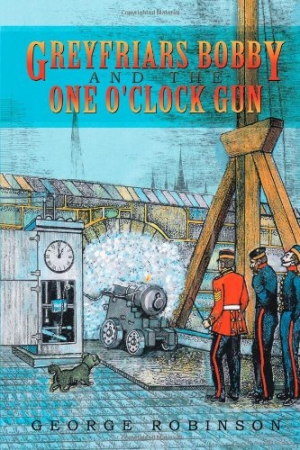Greyfriars Bobby and the One O'clock Gun
Scottish history comes alive through a famous canine hero.
Based on true events, real people, and an actual Skye terrier known throughout Edinburgh in the late 1800s, Greyfriars Bobby and the One O’Clock Gun, by George Robinson, provides a thorough, albeit disconnected, narrative of important historical events in Scotland’s capital city.
The early part of the book concentrates on the acquaintanceship of colour sergeant Donald Scott and the terrier, which he names Bob. Donald watches as the whole of Edinburgh embraces the terrier, even bestowing on him the more familiar name “Bobby.” Bobby proves himself a hero of sorts when he attacks a would-be mugger, sparing an old man whose silver watch is broken in the scuffle. It is while getting the watch fixed for this man that Donald, along with Bobby, accompanies the watchmaker and repairman to check the master clock of the observatory.
Much of the dialogue throughout this and other sections is too on-the-nose and explanatory. “As you’re probably aware, the correct time is essential when calculating longitude,” explains a professor. Outside of the occasional character who speaks with a convincingly captured Scottish accent—“I dinnae ken what I would have done if you and Bobby hadnae come along”—the story’s main players sound alike, also seeming to be matched point for point in terms of personality.
Donald and the terrier observe firsthand the time ball, Edinburgh’s time-signaling mechanism of those days, which drops at one o’clock daily to aid navigators in accurately setting their marine chronometers at sea. There is an excitement concerning the idea of such time balls spreading across ports worldwide that lasts until the device is upstaged by an especially resonant gun being automatically fired to sound the one o’clock signal.
Some scenes, such as that in which Donald gets a haircut before seeing the Highlanders arrive, are substantiated by neither new historical information nor plot movement. On the other hand, the arrival of the Highlanders provides an up-close view of Scotland’s military history, though the only plot to speak of invokes a pattern: something goes awry, and Bobby saves the day. In an ensuing episode, Donald saves the day by capturing a monkey wrecking his friend’s bar. While humorous enough in isolation, the scene hardly connects with surrounding material.
Over halfway through the book, we begin learning of Bobby’s adventures separate from Donald, including when the terrier attends Founder’s Day at Heriot’s and has his license purchased by the Lord Provost. This shift in focus, which not only sidelines the most familiar human character but also suddenly emphasizes Bobby over Scottish history, is disconcerting.
While scenes centered on historical moments do weave in humor—usually related to Greyfriars Bobby, as he becomes known—they largely resist both the input of characterization and integration into a stable narrative. While the real Greyfriars Bobby is an intriguing figure of Scotland’s past, this account does not supply the captivating behind-the-scenes minutiae or establish the cohesive flow of events that would really bring the story to life.
Inasmuch as a plucky pet is the central character, the book may best serve young readers interested in learning the history of Scotland.
Reviewed by
Hannah Eason
Disclosure: This article is not an endorsement, but a review. The publisher of this book provided free copies of the book and paid a small fee to have their book reviewed by a professional reviewer. Foreword Reviews and Clarion Reviews make no guarantee that the publisher will receive a positive review. Foreword Magazine, Inc. is disclosing this in accordance with the Federal Trade Commission’s 16 CFR, Part 255.

